Text
🇫🇷 French Panhard EBR Cavalry Squadron
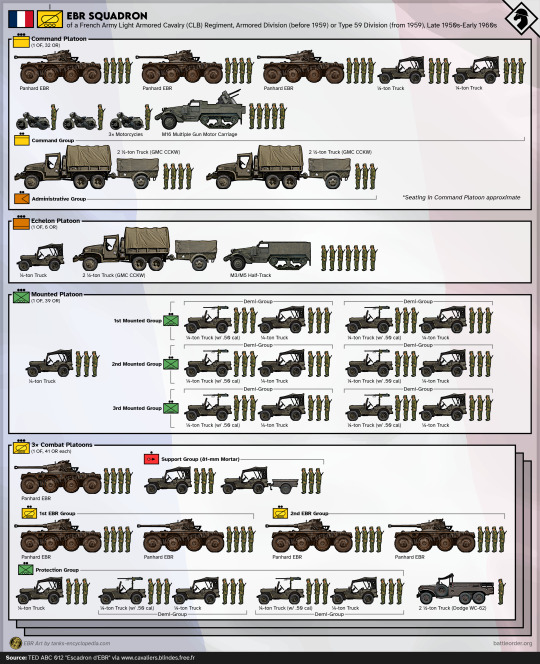
🇫🇷 The French Army Panhard EBR Armored Car Squadron of the late 1950s and early 1960s. These were part of the divisional cavalry regiments (the Régiment de cavalerie blindé léger or CBL) of Armored Divisions before 1959 and the Type 59 division post 1959.
#military history#military#armor#tanks#armored car#armee de terre#french army#battle order#algerian war#cavalry#history#1950s
13 notes
·
View notes
Text
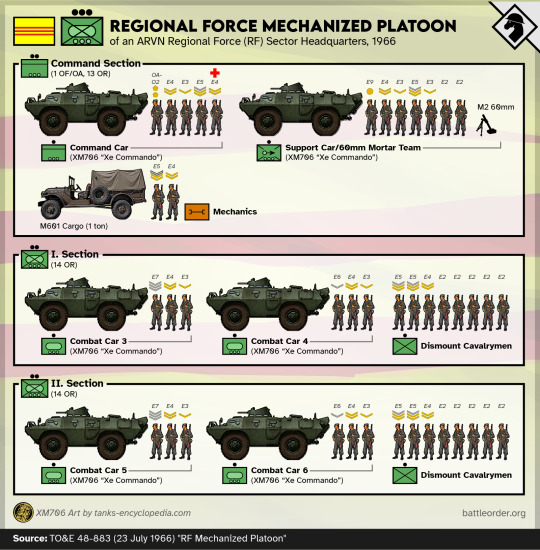
🟨 South Vietnamese (ARVN) Regional Force Mechanized Platoon, based on a 1966 TO&E.
The Regional Force was essentially a provincial territorial defense branch that ran in parallel to the regular ARVN units intended for offensive operations. The head of a RF Sector HQ was that province's Province Chief, and nominally an ARVN Colonel. They were both military heads and civil administrators, initially appointed by the area's Corps Commander. Popular Force meanwhile was essentially a static village-defense militia. RF and PF units operated together under the auspices of a District Chief, an ARVN Captain or Major in charge of a "Sub-Sector". They also at time assisted Regular ARVN operations.
The Mechanized Platoon gave a Sector HQ a mobile protection and security unit for patrolling the road net and acting as an intervention force. The Cadillac Gage XM706, known as the "Xe Commando" in Vietnam, was their main means. The precursor to DARPA shipped a few examples over to ARVN in 1963 for evaluation, and they began fielding it in 1965. It was initially equipped with two M1919A6 .30-06 MMGs but could be converted for 1x .30 cal and 1x .50 cal to boost its firepower. American Military Police (initially the 18th MP Brigade) would soon adopt a modified version of the platform for convoy escort duties.
I don't have the evidence yet but this structure seems a lot more like French cavalry during COIN operations of the 1950s/1960s than it does a U.S. Army MP unit. They lacked the MP's doctrinal law enforcement/EPW responsibilities and is somewhat similar to French practice of having a fair bit of infantry in armored car units to increase the cavalry's flexibility. ARVN mechanized units also had cavalry titles.
#vietnam war#south vietnam#arvn#cold war#armor#armored#armored car#cadillac gage#us army#military history#military#tactics
5 notes
·
View notes
Text

🟡 South Vietnamese (ARVN) Airborne Infantry Company Organization, 1968
#vietnam war#cold war#south vietnam#airborne#infantry#combat#war#special forces#paratroopers#arvn#military history#military
2 notes
·
View notes
Text

🇺🇸 The notional U.S. Army Armored Infantry Company from around 1948-1950. Notional because it includes the M44 Armored Utility Vehicle, which was a huge armored personnel carrier capable of carrying 24 passengers. It was initially an interim replacement for the M3 half-track, but its capacity and size was far in excess of the squad carrier requirement. The M44 was more suited for a cargo/prime mover role, but even in that capacity it was hypothesized as an unnecessary redundancy as early as 1949. Only a handful were made in reality. #battleorder
As of late 1940s, the M44's successor was already in the works and included in reference data. According to a 1949 report, the T18 (later M75, which was capable of fighting 12 men) was intended to fill the squad carrier role. In the report, it was stated that the M44E1 was allocated at the infantry/engineer squad-level, but that it should be replaced by the T18 as soon as possible. It looks like the T18 replaced the M44 in TO&Es theoretically as of a change in September 1950, but more practically in 1952 after mass production had started.
The succeeding M59, which was a more economical and amphibious APC, was declared the standard APC in May 1953 alongside the T18/M75. The M75 would be phased out by the more numerous M59 by the late 1950s. The M59 would in turn lead into the M113, which began production in January 1960. After the M113's adoption, the M59 and its derivatives saw service well into the 60s and even the 70s, mainly in non-close combat roles (like as command posts and mortar carriers) and in the lower priority National Guard units. Countries using them as foreign aid kept them around significantly longer.
Key unit capabilities in this notional state include "Dismounted support of tanks, normal infantry action with or without tank support; high cross-country mobility with light armored protection when mounted; and greater automatic fire support than other infantry." Armored Infantry Battalions were organic to Armored Divisions.
1 note
·
View note
Text
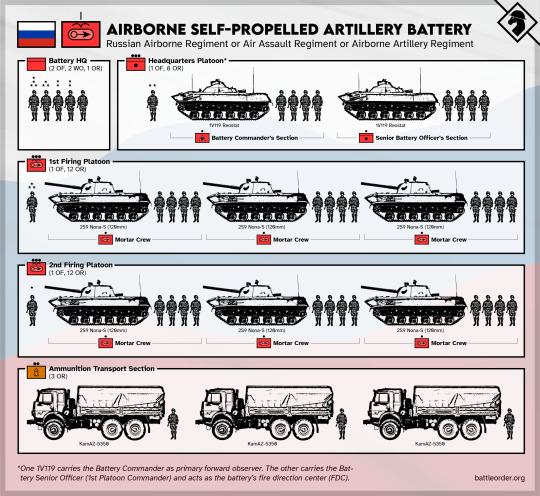
🇷🇺 Graphic of the Russian Airborne Self-Propelled Artillery Battery, equipped with 2S9 Nona-S self-propelled mortars. These are the main artillery for Airborne and Air Assault Regiments (as an 18-gun battalion, 3 batteries), possibly for Airborne Battalions part of Air Assault Brigades (1 battery), and are part of the Airborne divisional artillery (Artillery Regiments). The VDV also make use of D-30 towed 122mm howitzers in brigade and divisional artilleries.
⚔ The structure overall is very similar to a standard self-propelled artillery battery, except with the air droppable Nona-S instead of Msta/Akatsiya/Gvozdika howitzers and 1V119 artillery command vehicles based on BTR-D airborne APC rather than MT-LBu variants. The HQ includes a command vehicle for the Battery Commander (typically primary forward observer in a battery, setting up a command outpost) and Senior Battery Officer (stays with the battery and leads the FDC). The Battery Commander is supported by scouts while the Senior Battery Officer is supported by a fire calculator. The rest of the HQ is more rear echelon oriented, like the Senior Technician, Starshina, and Medical NCO.
⚔ The battery has two firing platoons, each with 3 mortars, and is supported by an ammunition section with 3 trucks.
#russian army#ukraine war#artillery#infographic#battleorder#military#military history#vdv#airborne#paratroopers
2 notes
·
View notes
Text
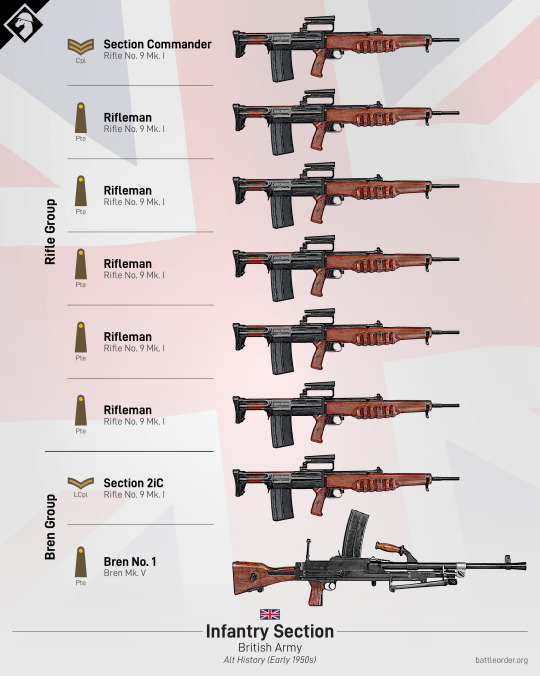
⚔ A plausible alternate history scenario where the British Army continued to use the Janson E.M.2 rifle, officially adopted as the Rifle No. 9 Mk. 1 in 1951. This bullpup ultimately never entered mass production, as the incoming Churchill government was more interested in NATO standardization than the minutae of the British Army's service weapon (so this is perhaps a "What if Churchill's Conservatives lost the 1951 election scenario?). The weapon was chambered .280 British, which the U.S. government did not favor. So, although the E.M.2. was adopted, this left the British Army using the Lee-Enfield No. 4 and WWII-vintage arms for several more years before the adoption of the L1A1 SLR (FAL-derived) in the late 1950s.
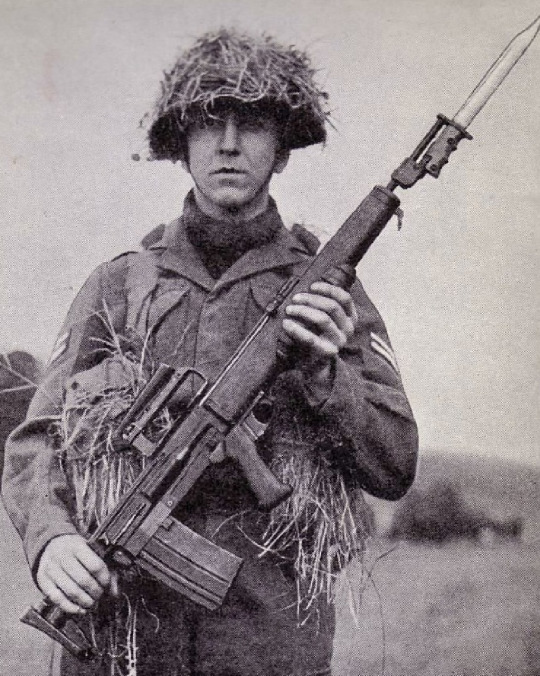
⚔ This graphic shows what a British Infantry Section might've looked like if the E.M.2 had remained in service. This takes into account the direction the British were heading with their sections, that being 8-man for light role and 10-man for mechanised. For the section automatic, we assume that the X11 Turpin GPMG still in its experimentation phase would still have not been in service by the early 1950s. We believe that before adopting a proper GPMG, the British would have either continued using the Bren chambered in .303 or converted Brens to .280 (as pictured). This is essentially what they did when they adopted 7.62 NATO. We label the converted Bren as the Bren Mk. V. The 7.62 NATO Brens were adopted as the L4A1 years after the L number system was introduced (1954). If a .280 Bren was adopted in the early 50s we believe it likely would've been designated the L2A1, coming after the L1A1 .50 HMG (M2 Browning).
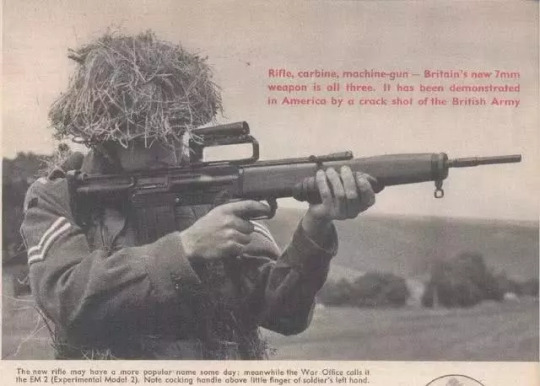
#alt history#british army#cold war#firearms#military fantasy#military#infographic#battleorder#em2#infantry
12 notes
·
View notes
Text
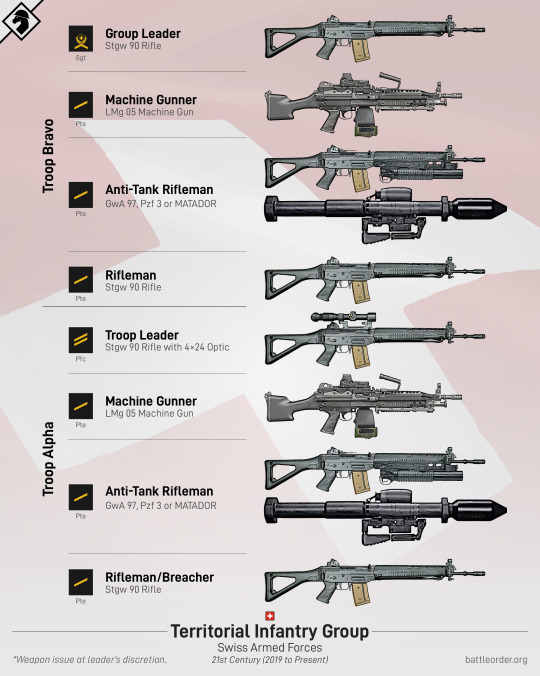
🇨🇭The current Swiss Territorial Infantry Group. Switzerland's four Territorial Divisions are one part of their ground combat capacity, the other being the Swiss Army with its armoured maneuver formations. Territorial Divisions are broadly responsible for local defense and disaster response, tied to geographically defined territories.
⚔️ The group consists of 8 soldiers and are typically carried in an APC 93 (Mowag Piranha II 8x8) or Mowag Duro, which are manned by an additional 3 vehicle crew (commander, gunner, driver). Exact distribution of weapons varies based on unit preference, but the group is typically split into two Troops (one under the Group Leader and one under the Troop Leader).
⚔️ Key weapon systems include two FN Minimi LMGs, one or two 40mm underbarrel grenade launchers, one or two Panzerfaust 3s (to be supplemented by the MATADOR, which makes sense due to the Swiss' urban combat strategy), and one or two optics to create DMRs. Groups will also have one member trained in demolitions and breaching. An interesting aspect of the Swiss group is due to the limited time frames available for training their conscripts, there is a high degree of segmentation in specialisms. For example, a soldier trained on an LMG may not receive a qualification to operate the Panzerfaust 3.
⚔️ Another variation we've been told of and have seen photographic evidence for is giving the AT Rifleman the DMR and giving the UBGL to Riflemen. However, the allocation of the DMRs likely depends on who in the group is the best shot.
#swiss army#switzerland#infantry#infographic#military#military history#armor#soldiers#firearms#battleorder
13 notes
·
View notes
Text

🇷🇺 The theoretical Russian Motor Rifle Squad when mounted in the BMP-2 or BMP-3 infantry fighting vehicle. It differs from those squads mounted in BTRs or BMP-1s in that those squads have an additional rifleman (previously an SVD marksman). Although they don't serve exclusively in tank units, Motor Rifle units that support tank-heavy units are more likely to be mounted in BMPs.
---Structure--- ⚔ Russian Motor Rifle Platoons consist of 3 vehicles with a Platoon Commander, Deputy Platoon Commander and 3 squads. Part of the 2008 reforms saw the platoons streamlined a fair bit, with platoon-level PKM/PKP teams and SVDs going away and the PKP being integrated at the squad level replacing the RPK. Some platoons may even see the Deputy Platoon Cmdr as a Squad Leader (to reduce the number of contract NCOs needed?)
⚔ Each squad consists of a vehicle crew and a dismount element (which doctrinally can be split into a Fire Group and Maneuver Group). The Squad Commander acts as both a vehicle commander when he's mounted and commander of the overall squad when he dismounts. When he dismounts, the Gunner-Operator takes over command of the vehicle and directs the driver, receiving instruction from the Deputy Platoon Commander who also stays mounted.
⚔ The dismount element further consists of a Senior Rifleman, Grenadier (RPG-7), Assistant Grenadier, PKP Gunner, and Rifleman. The Squad Commander typically leads the Fire Group doctrinally, which can have the Grenadier and PKP Gunner. The Maneuver Group meanwhile is lead by the Senior Rifleman.
---Equipment--- ⚔ The standard rifle in the Motor Rifles is the AK-74M. The new AK-12 is meant to replace it eventually, but elite units like VDV and Spetsnaz have priority for the limited amount available. I have been told that the Maneuver Group, consisting of the Senior Rifleman and Rifleman, are most likely to get underbarrel grenade launchers.
⚔ The standard squad automatic is the PKP, which was previously a platoon MG before 2008. Other than the equipment shown here, disposable anti-tank weapons like the RPG-18 are also available.
7 notes
·
View notes
Text
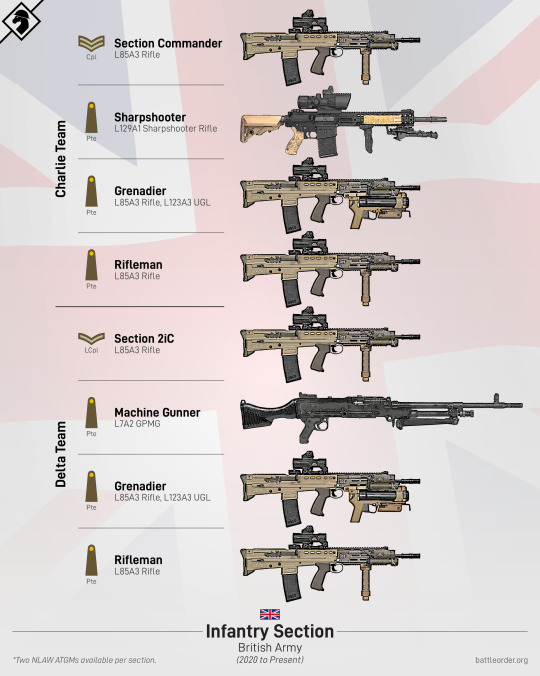
🇬🇧 The current British Army Infantry Section, factoring in organizational changes from 2018 and new modifications to the L85A3.
---Structure--- ⚔ The British Infantry Section consists of 8 men split into two fire teams (Charlie under the Section Commander and Delta under the Second-in-Command). Who goes in what fire team depends on the situation and preference, but generally the Section 2iC leads any sort of support-by-fire element (which normally includes the L7A2 general-purpose MG; sometimes the Sharpshooter as well). Other than leadership, key personnel include a Sharpshooter, 2 Grenadiers, 1 GPMG Gunner, and 2 Riflemen. Infantry Platoons are compoed of three such sections, in addition to a small Platoon HQ.
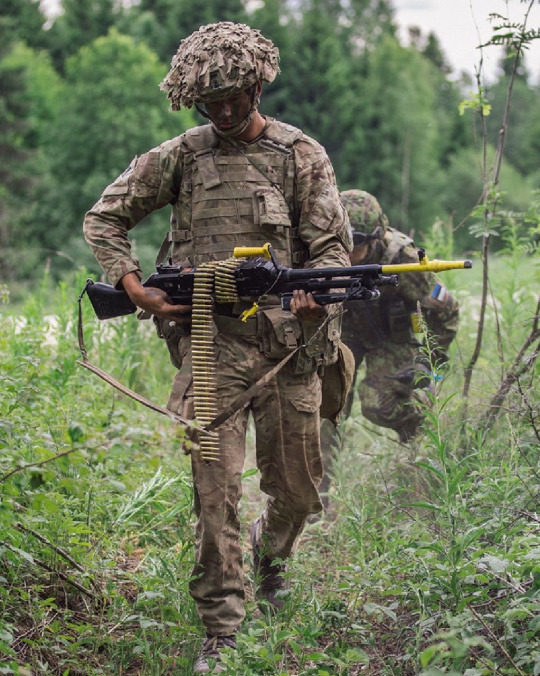
---Equipment--- ⚔ The standard service rifle is the L85A3, which is gradually replacing the L85A2. This graphic includes the new M-LOK handguards, replacing the KeyMod handguards it was adopted with. It also shows the new mounting system for the L123A3 grenade launcher. Previously, the old L85A2 mounting system was still being used on the L85A3.
⚔ The Sharpshooter is equipped with the L129A1, an LMT-produced rifle that replaced the L86 LSW in a designated marksman role in 2009. In 2018, the L7A2 GPMG was reintroduced to the section (having been taken out in the late-1980s), coinciding with the removal of the L110A1 LMG (version of the FN Minimi). The rationale was that the British trials unit stated that the Minimi was ineffective past 250 meters. Whether this is actually true or not, the Army decided it was not worth the weight burden to keep the Minimi in the section for that limited capability. The basic theory is the grenade launcher and rifle can suppress targets at shorter ranges, the sharpshooter can offer accurate point suppression at longer ranges, and the GPMG can offer area suppression at longer ranges. The area suppression role is why British L7A2s lack optics.
⚔ NLAW anti-tank guided missiles are available to each section. Depending on operational need, Glock 17 pistols can be issued to the section (as was seen in Afghanistan). This may be seen for future COIN deployments.
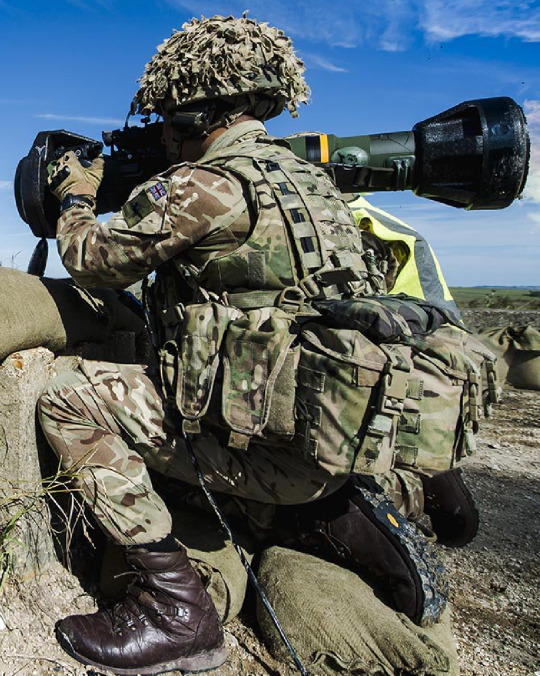
#gpmg#british army#infantry#ally#nato#military#military history#firearms#infographic#l85#paratroopers#airborne#battleorder
18 notes
·
View notes
Text
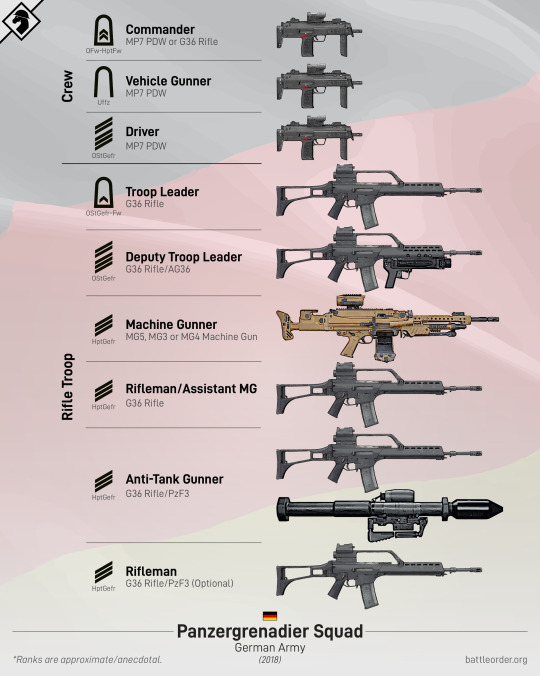
🇩🇪 The German Panzergrenadier Squad consists of the Vehicle Crew and the Rifle Troop (dismount element) with the Squad Leader (Gruppenführer) acting as the Vehicle Commander. If an operation is vehicle-centric, the Troop Leader (Truppführer) will lead the dismounts. But, if the operation is dismount-centric, the Squad Leader may lead the dismounts instead. The squads, mounted in the Puma or Marder IFV, will have 6 dismounts (one less than Jäger squads mounted in the Boxer which is 3 crew + 7 dismounts).
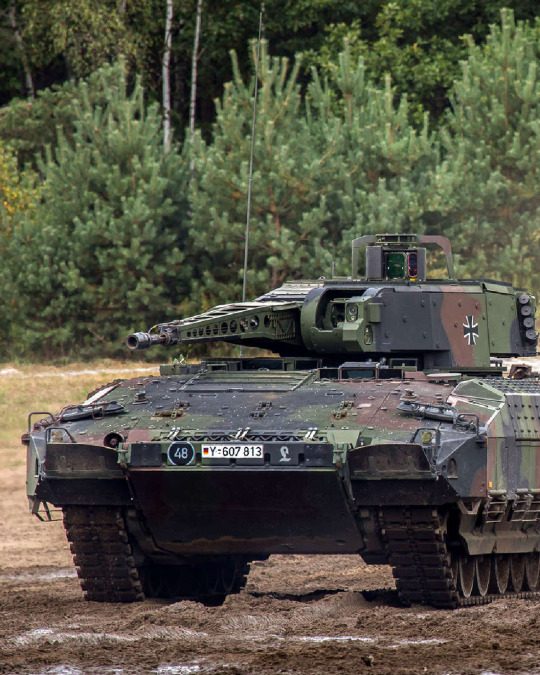
⚔ The MP7 personnel defense weapon appears to be a standard weapon for vehicle crews in the Bundeswehr, include tankers, IFV and APC crews. It replaced the Uzi in this role. However, there does seem to be some intention for the Bundeswehr to move to G36K Carbines for Panzergrenadier vehicle crews based on promotional displays. As for the dismounts, the Germans run a sort of weapons locker concept where different weapons can be taken out. The Machine Gunner for example can man either an MG5 GPMG chambered in 7.62 NATO (or MG3 if the unit hasn't gotten MG5s yet) or an M4 LMG chambered in 5.56 NATO. The vehicle will also carry multiple Panzerfaust 3 anti-tank weapons which one or more Riflemen can take out depending on mission requirements. Typically one of the 6 dismounts will act as an assistant to the MG, and one or two soldiers may carry an AG36 underbarrel grenade launcher. The HK69A1 standalone grenade launcher or "Granatpistole 40 mm" is also in use.
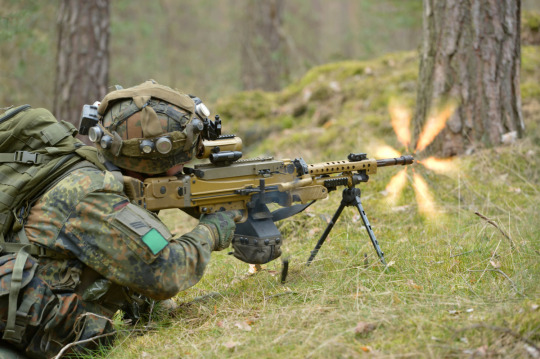
#german army#bundeswehr#nato#modern warfare#heckler & koch#military#firearms#panzergrenadier#infantry#armor#military history#infographic#battleorder
21 notes
·
View notes
Text

🇫🇷 The Dragons Portés were French motorized infantry during the interwar and early WWII, so-called because of their cavalry affiliation. They were the contemporaries of the Panzergrenadiers, although not as well resourced. The infantry branch's motorized infantry were called things like Chasseurs Portés or simply Infanterie motorisé. The Division Cuirassée (Armored Division that was subordinate to the infantry branch rather than the cavalry was meant to have a battalion of Chasseurs Portés or mounted chasseurs for example).
⚔ The Dragoons were part of the Light Mechanized Divisions (DLM) and Light Cavalry Divisions (DLC), the former of which was an entirely mechanized/motorized exploitation force. The organization shown is the DLM variant, which were mounted mainly on 6x6 off-road trucks. The smaller DLC variant was mounted on Citroen P19 Kegresse Half-Tracks. Each DLM division had one Dragoon regiment as infantry support.
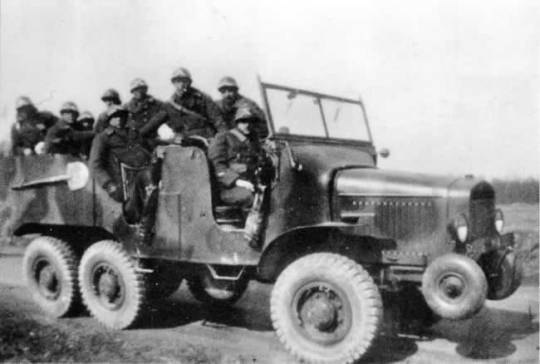
⚔ One or two Dragoon battalions were typically meant to reinforce a brigade-sized tactical group (Groupement tactique) under the division that consisted of a tank regiment (2 battalions), 1-2 Dragoon battalions and a squadron-sized Discovery Detachment (a mix of armored cars and motorcyclists for recon from the division's Discovery Regiment).
⚔ The Dragoon battalion itself had a reconnaissance squadron with AMR 35 light tanks, or H39 as a substitute. These tanks likely worked closely with the motorcyclists, as other units had mixed light tank-motorcycle squadrons in lieu. So it was a combined arms battalion in its own way. The battalion's MG and Support Vehicle Squadron had 8x 8mm MGs, 4x 81mm mortars and 4x 25mm AT cannons.
#armée de terre#french army#infantry#armor#infanterie#dragoons#ww2#wwii#military#military history#world war ii#infographic#orbat#battleorder
6 notes
·
View notes
Text

🇫🇷 Check out our new video linked in the bio on the French Army Infantry Squad! The video takes a look at the current organization and what new equipment the Army is procuring for it.
⚔ This graphic depicts what the squad will look like pending planned procurement. The squad consists of a Squad Leader, Marksman, Alpha Team (formerly 300m Team), and Bravo Team (formerly 600m Team), and a Vehicle Crew. This applies to squads mounted in the VAB, VHM, VBCI, and VBMR armored infantry carriers. The Alpha Team is the junior fire team and the primary assault element, with riflemen and short-range anti-armor weapons. The Bravo Team is the senior fire team and the primary support by fire element, with a light machine gun and mortar-style grenade launcher.

⚔ Each Infantry Platoon consists of a small Platoon HQ (Command Team), 3 of these Squads, and a Support Squad (weapons squad).
#french army#armée de terre#france#military#infantry#military history#heckler & koch#infanterie#infographic#battleorder#army#nato
10 notes
·
View notes
Text

🇺🇸 Notional late 70s/early 80s U.S. Army Mechanized Infantry Squad task organized to conduct an anti-armor ambush, with an Armor-Killer Team (with M47 Dragon ATGM) and Support/Security Team with M72A2 LAWs to supplement.
⚔ This is based on the 1977 field manual for the Mechanized Platoon and Squad, mounted in the M113 armored personnel carrier. The manual gives several variations to the squad based on different conditions, such as being understrength or to tailor it to a specific mission. Because there were distrinct Carrier Teams (minimum of 2 but possibly more) and Maneuver Teams (which themselves could be split as necessary) there was a lot of variation within the manual depending on unit SOPs.

⚔ Generally speaking, squads were 11 men at the time with a dedicated 2-man crew for the track (but more could stay behind if necessary). The Platoon HQ had 3 M47 Dragon ATGMs to distribute to the squads (but squads didn't need to take them out if unnecessary). Each squad organically had its own M60 machine gun, but the platoon had an additional 2 M60s to reinforce 2 of the squads. M72A2 LAWs and other munitions were distributed as necessary but about 3-5 LAWs is commonly mentioned in the manual.

⚔ These were the infantry that would typically work with friendly armor units in Mechanized and Armored Divisions. Light infantry (infantry, airborne, air assault, rangers) also had 11-man squads but were split into a 5-man Alpha Team and Bravo Team under the SL.
#military#military history#infographic#us army#infantry#cold war#mechanized infantry#armor#special forces#firearms#battleorder
13 notes
·
View notes
Text

🇮🇹 The Italian Army Reconnaissance Squadron equipped with B1 Centauros and Iveco LMVs. These are the primary reconnaissance elements of Italy's brigades.
⚔ A Brigade Reconnaissance Squadrons Group currently has 3 Recon Squadrons (this) and a Heavy Armour Squadron, which has platoons with 4 Centauros. In the Recon Squadron, the Centauros provide direct fire support and security to lighter recon teams and fight for information, while the Heavy Armour Squadron's Centauros act more as light tanks for tasks such as counterattacking or conducting penetrations. B1 Centauros in the Recon Squadrons will be replaced by Freccias and those in the Heavy Armoured Squadron will be replaced with the upgunned (120mm) Centauro II.

#italian army#esercito italiano#b1 centauro#armor#tanks#cavalry#cavalerie#military history#modern warfare#military#infographic#battleorder
6 notes
·
View notes
Text

🇷🇺 Russian Air Assault Company (VDV), mounted in BMD airborne infantry fighting vehicles.
⚔ As with most Russian units, the Company HQ has key staff personnel which are carried in vehicles provided by a separate Headquarters Squad (at higher echelons a signals unit). In this case, it includes a Company Commander, Deputy Company Commander, Deputy Company Commander (Parachute Instructor), Senior Technician, Starshina (Sergeant Major type), and a Medic. Mountain Air Assault units, like those of the 7th Guards Air Assault Division, also get a Mountain Training Instructor here.
⚔ The Grenade-Machine Gun Platoon provides a limited firepower boost, with its Squad Leader manning an NSV heavy machine gun and another two teams manning RPG-7Ds.
⚔ The close combat units of the company are the Air Assault Platoons, each with 3x squads mounted on BMD-4 or BMD-2 airborne infantry fighting vehicles. One squad is led by the Deputy Platoon Commander (probably a Senior Sergeant) and furnishes the platoon's one RPG-7D, while the other squads have one PKP general-purpose machine gun instead.
#opfor#army#military#ukraine#ukraine war#russian army#military history#infographic#infantry#armor#battleorder
3 notes
·
View notes
Text

🇨🇦 The modern Canadian Army Light Infantry Rifle Section as per doctrine. Each section is 10 infanteers overall, but unlike the Mechanized Infantry section slots aren't eaten up by dedicated vehicle crew.
---Structure--- ⚔ The Canadian Light Rifle Platoon generally consists of a Platoon Headquarters, Weapons Detachment (with a C6 GPMG and Carl Gustav recoilless rifle) and 3 Rifle Sections.
⚔ The building block of the Rifle Section is the Fire Team (equivalent to an American buddy team), with sections being divided into Alpha, Bravo, Charlie, and Delta Teams (ordered BACD for battle drills). These teams are then ordered into two assault groups, Group 1 and Group 2. This set up can vary somewhat, but generally speaking the Section Commander (a Sergeant) is in Team A (Group 1) and the Section Second-in-Command (a Master Corporal or senior Corporal) is in Team D (Group 2). The Section Third-in-Command (a senior Corporal) can be in either Team B or C and can take over the duties of the 2iC if necessary.
⚔ This set up allows for the section to maneuver either as groups (e.g. Group 1 supporting-by-fire Group 2's assault) or by fire team, whereby individual fire teams bound forward or are given separate tasks (e.g. Bravo Team lays down suppressing fire while Alpha Team assaults). This method of individual fire and maneuver is termed "pepper potting".
---Equipment--- ⚔ The standard service weapon of the section is the C7A2 rifle, although these can be substituted with C8A3 carbines depending on the unit. All weapons in the section are equipped with C79 3.4x magnification optics (M145 MGO in American service). Each section has two Machine Gunners equipped with C9A2 LMGs (based on the FN Minimi) and two Grenadiers with M203A1 grenade launchers (with SOPMOD-length 9-inch barrels). For anti-structure and light anti-armor work, M72 LAWs, the SRAAW(L) in Canadian service, are also available for issue, usually to Riflemen.
#canadian army#armee#army#infantry#militaryhistory#canada#military#firearms#airborne#paratroopers#infographic#battleorder
5 notes
·
View notes
Text
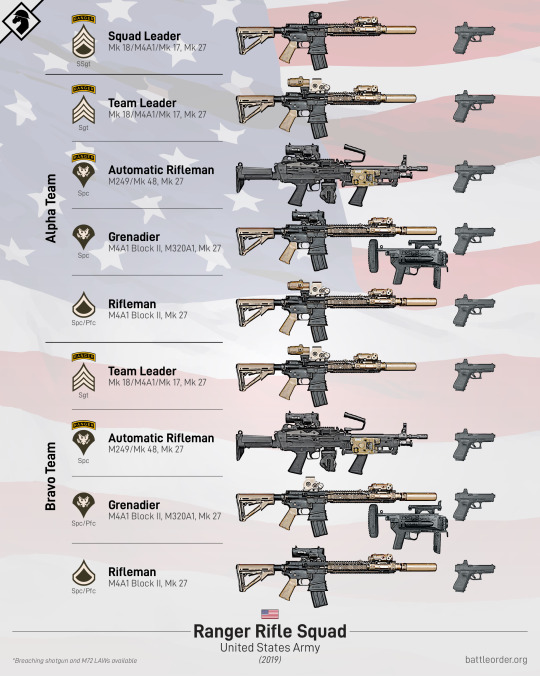
🇺🇸 The U.S. Army Ranger Rifle Squad circa 2019, with input from a former Ranger. The exact accessories on the weapons have changed a little bit since then.
⚔ Organizationally, the Rangers are similar to normal light infantry up to the company-level with only minor modifications. For this reason, they could be considered the Army's most elite true infantry. What they differ in is their missionset, selection standards, deployment tempos, and budgets for gear and training. The Ranger specialize in missions like airfield seizures, direct action raids, and providing security and mass for other special operations units.
---Structure--- ⚔ The organization of the squad is identical to the standard rifle squad, with a Squad Leader and two Fire Teams (Alpha and Bravo). In theory, each team has a Team Leader, Automatic Rifleman, Grenadier and Rifleman. However, due to low manpower, squads usually run smaller.
⚔ One unique aspect of the Rangers is the status of the Ranger tab. Completely separate from the 75th Ranger Regiment is Ranger School, which is a leadership school focused on infantry skills. This is unrelated to Ranger selection. Anyone can go and all infantry officers are expected to attend. All those in the Ranger Regiment must earn their Ranger tab before they can fill any sort of leadership position. The graphic shows the Squad Leader, both Team Leaders and Automatic Riflemen (doctrinally an assistant team leader) with tabs. All non-tabs are considered Privates, even if they rank Specialist.
---Equipment--- ⚔ The standard rifles for the Rangers are the Mk18 and M4A1 Block II. The Mk17 (SCAR-H) can also be used by tabbed squad members, although most prefer the Mk18. The standard squad automatic is the M249 LMG, same as the normal squad, although this can sometimes be substituted with the Mk48 chambered in 7.62mm. All members are allotted a Glock 19 pistol, although they can choose whether they carry it or not.
⚔ A variety of optics are used, with ELCAN Spectres, Aimpoint T2s and Eotech EXPS3s shown. Grips are also used, including mag well extenders.
#us army#special forces#us army rangers#75th ranger regiment#infantry#paratroopers#airborne#military history#military#firearms#infographic#army#battleorder
32 notes
·
View notes